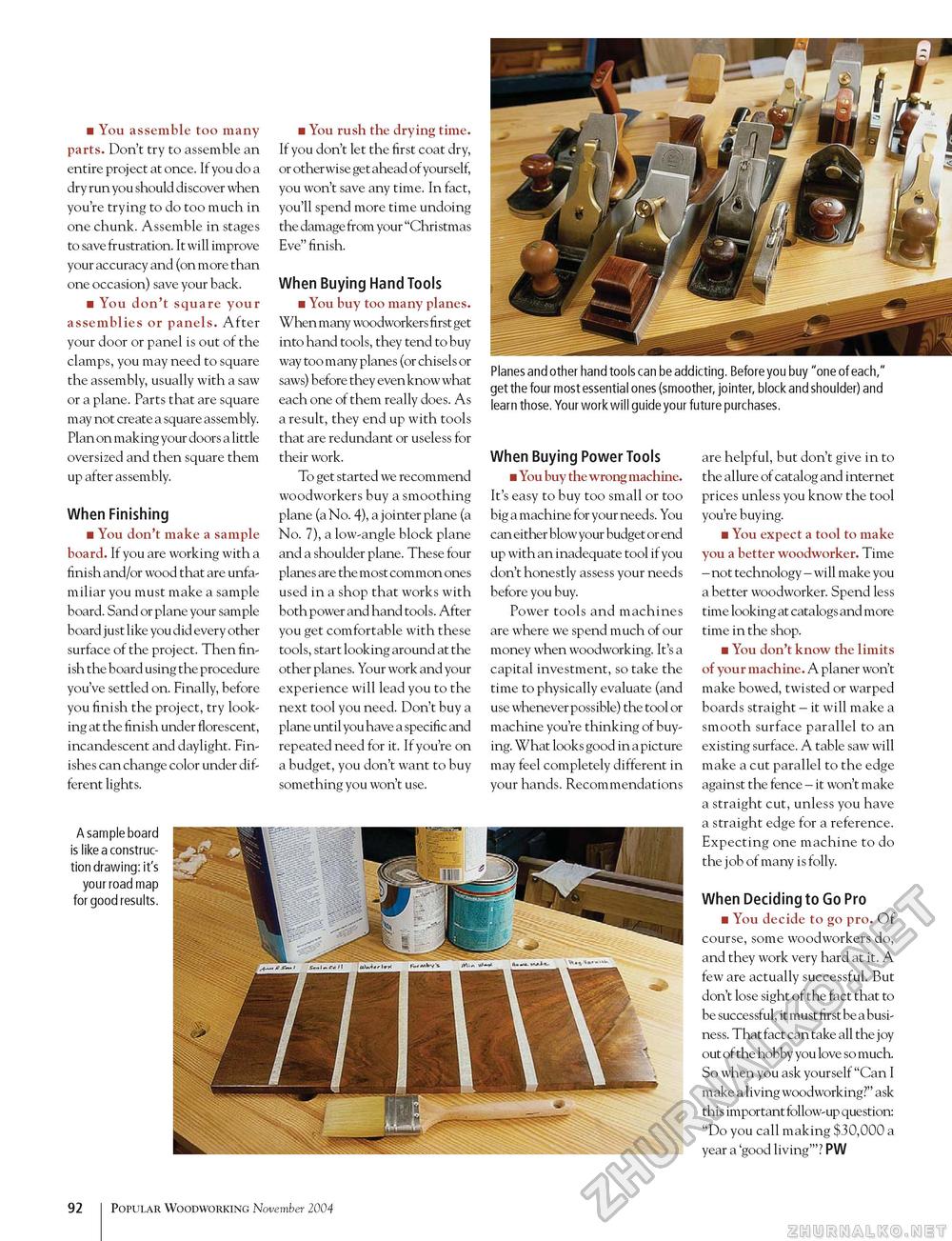Popular Woodworking 2004-11 № 144, страница 93
■ You assemble too many parts. Don't try to assemble an entire project at once. If you do a dry run you should discover when you're trying to do too much in one chunk. Assemble in stages to save frustration. It will improve your accuracy and (on more than one occasion) save your back. ■ You don't square your assemblies or panels. After your door or panel is out of the clamps, you may need to square the assembly, usually with a saw or a plane. Parts that are square may not create a square assembly. Plan on making your doors a little oversized and then square them up after assembly. When Finishing ■ You don't make a sample board. If you are working with a finish and/or wood that are unfamiliar you must make a sample board. Sand or plane your sample board just like you did every other surface of the project. Then finish the board using the procedure you've settled on. Finally, before you finish the project, try looking at the finish under florescent, incandescent and daylight. Finishes can change color under different lights. A sample board is like a construction drawing: it's your road map for good results. ■ You rush the drying time. If you don't let the first coat dry, or otherwise get ahead of yourself, you won't save any time. In fact, you'll spend more time undoing the damage from your "Christmas Eve" finish. When Buying Hand Tools ■ You buy too many planes. When many woodworkers first get into hand tools, they tend to buy way too many planes (or chisels or saws) before they even know what each one of them really does. As a result, they end up with tools that are redundant or useless for their work. To get started we recommend woodworkers buy a smoothing plane (a No. 4), a jointer plane (a No. 7), a low-angle block plane and a shoulder plane. These four planes are the most common ones used in a shop that works with both power and hand tools. After you get comfortable with these tools, start looking around at the other planes. Your work and your experience will lead you to the next tool you need. Don't buy a plane until you have a specific and repeated need for it. If you're on a budget, you don't want to buy something you won't use. Planes and other hand tools can be addicting. Before you buy "one of each," get the four most essential ones (smoother, jointer, block and shoulder) and learn those. Your work will guide your future purchases. When Buying Power Tools ■ You buy the wrong machine. It's easy to buy too small or too big a machine for your needs. You can either blow your budget or end up with an inadequate tool if you don't honestly assess your needs before you buy. Power tools and machines are where we spend much of our money when woodworking. It's a capital investment, so take the time to physically evaluate (and use whenever possible) the tool or machine you're thinking of buying. What looks good in a picture may feel completely different in your hands. Recommendations are helpful, but don't give in to the allure of catalog and internet prices unless you know the tool you're buying. ■ You expect a tool to make you a better woodworker. Time - not technology - will make you a better woodworker. Spend less time looking at catalogs and more time in the shop. ■ You don't know the limits of your machine. A planer won't make bowed, twisted or warped boards straight - it will make a smooth surface parallel to an existing surface. A table saw will make a cut parallel to the edge against the fence - it won't make a straight cut, unless you have a straight edge for a reference. Expecting one machine to do the job of many is folly. When Deciding to Go Pro ■ You decide to go pro. Of course, some woodworkers do, and they work very hard at it. A few are actually successful. But don't lose sight of the fact that to be successful, it must first be a business. That fact can take all the joy out of the hobby you love so much. So when you ask yourself "Can I make a living woodworking?" ask this important follow-up question: "Do you call making $30,000 a year a 'good living'"? PW 92 Popular Woodworking November 2004 |








